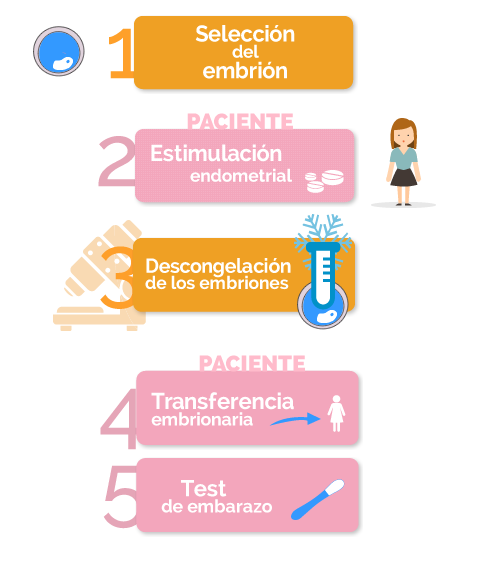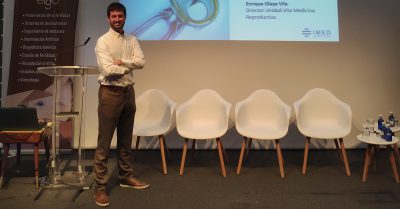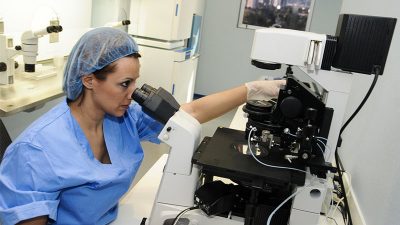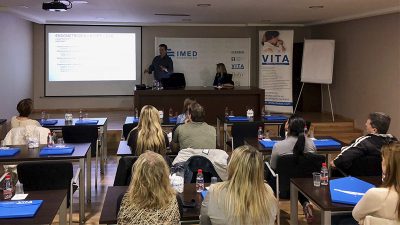Embryo adoption: adoption of embryos

The reception of donated embryos is a technique where a donated and previously vitrified embryo is transferred to the patient. Donated embryos generally come from couples who have undergone an assisted reproduction treatment and have managed to become parents, so the spare embryos are cryopreserved to be donated to another couple.
It is a simple and economical option, since it only requires endometrial preparation of the recipient patient.
What is embryo adoption?
Previously, one or two cryopreserved embryos are selected from the bank of donated embryos. This selection is based on a rigorous study of the characteristics of the embryos and of the future parents (blood group, Rh and phenotype), seeking genetic compatibility.
Embryo reception does not require to be on a waiting list. It is a simple and fast process.
The patient will follow an endometrial preparation treatment to be able to receive the embryos.
At the moment the recipient of the embryos menstruates, she will start an estrogen treatment, in increasing doses, to achieve the adequate endometrial thickness, which will be assessed by vaginal ultrasound scans.
Once the endometrium has grown, the embryos can be thawed and transferred. To facilitate embryo implantation, progesterone is administered vaginally.
The embryos that have been donated by other couples remain cryopreserved through a vitrification process and stored in suitable tanks filled with liquid nitrogen that keeps them at -196ºC.
The thawing of the embryos is a process that consists of going from a temperature of -196ºC to a body temperature of 37ºC. In addition, the embryos are incubated in a series of specific media, so that the cryoprotectants (substances used for freezing) are replaced by water, thus achieving cell rehydration and reactivating the biological functions of the embryo.
At VITA, we have the infrastructure and the specialized human team necessary to carry out embryo freezing or cryopreservation using the latest techniques (vitrification) as well as its subsequent thawing.
Normally, the embryos are thawed on the day of the transfer, a few hours before in order to verify they have survived the process. According to Spanish legislation, no more than three embryos can be transferred per cycle. The patients and the center’s medical-biological team will decide the appropriate number of embryos to transfer.
The gynecologist will use a small catheter to guide the embryos through the cervix and into the uterus. The embryo transfer procedure lasts a few minutes and patient recovery time is minimal.
Normally the embryos are frozen on day 5 of embryonic development, so the pregnancy test will be carried out by means of a blood test 10 days after the embryo transfer.
If the patient suffers from bleeding before the test is performed, it is important that she never stops taking the medication and that she contacts the medical team for advice.
Throughout the treatment, her personal assistant will be available at all times to answer any questions she may have and support her in this very special moment.

For whom is this technique indicated?
Embryo reception is indicated for
- Couples or single women who want a simple and cheap assisted reproduction treatment.
- Couples or single women where the woman has ovulatory dysfunctions such as premature ovarian failure, menopause or when there is no response to ovarian stimulation.
- Couples or single women who want to adopt, but either the waiting list is too long, or they want to enjoy pregnancy, childbirth and breastfeeding.
- Couples with genetic anomalies in both spouses.
- Couples who have repeatedly failed at other assisted reproduction techniques.
- Couples that have suffered recurrent miscarriages.
Requirements:
- It is necessary for the embryo to share a series of characteristics with the future parents (blood group, Rh and phenotype).
The cost of this reproduction treatment is much lower since the treatment required by the receiving mother is very simple and takes little time. It simply requires to prepare the endometrium and by means of an ultrasound scan to observe the ideal moment for the transfer. Therefore, visits to the assisted reproduction centre are significantly reduced.
Aware that embryo reception can lead to possible emotional changes, at VITA we have a team of psychologists fully available to the patient to provide the necessary support to face the treatment.
Where do the donated embryos come from?
In most cases, the embryos come from couples who have previously undergone an IVF treatment and who, after becoming parents, decide to donate their good-quality surplus embryos to other couples.
These embryos remain frozen by means of vitrification, an ultra-fast freezing technique that allows to cryopreserve them in perfect conditions for future in vitro fertilization cycles.
The probability of success is slightly lower than for an in vitro fertilization with fresh embryos, but taking into account the simplicity of the treatment, its promptness (it only requires endometrial preparation of the recipient patient) and low cost, it is a technique that should be considered.





